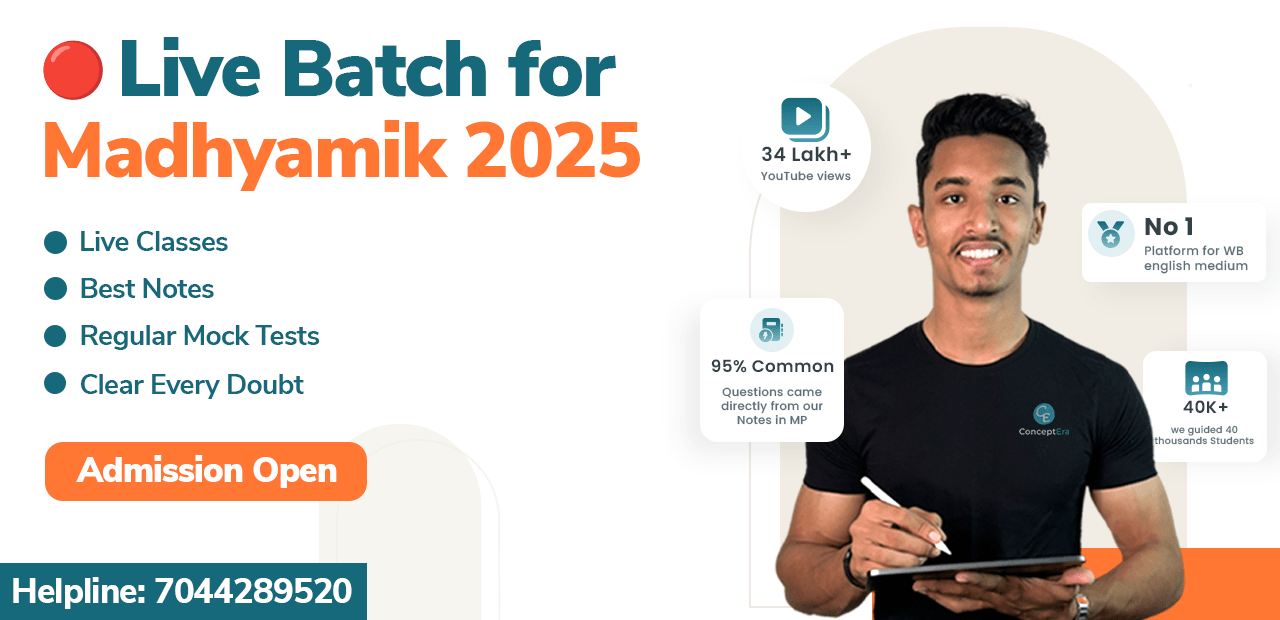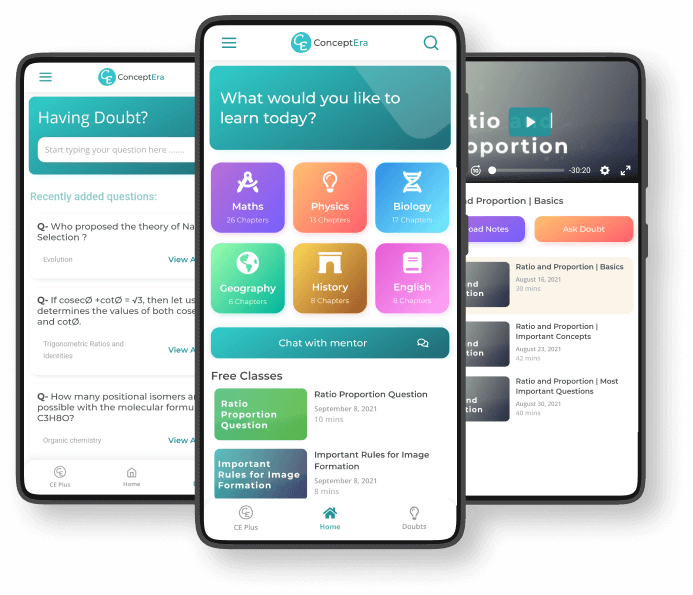Group-A
1. Multiple choice question.
1.1 Mohan Bagan Club won the I.F.A. Shield in the year —
(a) 1890 A.D.
(b) 1905 A.D.
(c) 1911 A.D. (Ans)
(d) 1917 A.D.
1.2 Dadasaheb Phalke was associated with —
(a) Films (Ans)
(b) Sports
(c) Local History
(d) Environmental History
1.3 The ‘Grambarta Prakashika’ was published from-
(a) Jessore
(b) Ranaghat
(c) Kusthia (Ans)
(d) Barasat
1.4 The first B.A. Examination of Calcutta University was held in ——
(a)1857 A.D. (Ans)
(b) 1858 A.D.
(c) 1859 A.D.
(d) 1860 A.D.
1.5 The first Principal of Calcutta Medical College was —
(a) Dr. M. J. Bramley (Ans)
(b) Dr. H. H. Goodeve
(c) Dr. N. Wallich
(d) Dr. J. Grant
1.6 Titu Mir’s real name was —
(a) ChiragAli
(b) Hyder Ali
(c ) Mir Nisar Ali (Ans)
(d) TorapAli
1.7 One of the leaders of Sannyasi-Fakir rebellion was—
(a) Rani Karnabati
(b) Rani Shiromoni
(c) Debi Chaudhurani (Ans)
(d) Rani Durgabati
1.8 The song “Bande Mataram” was’ composed in the year —
(a) 1870 A.D.
(b) 1872 A.D.
(c) 1875 A.D. (Ans)
(d) 1876 A.D.
1.9 ‘Bartaman Bharat’ was written by —
(a) Akshay Kumar Datta
(b)Rajnarayan Bose
(c)Swami Vivekananda (Ans)
(d)Ramesh Chandra Majumdar
1.10 Gaganendra Nath Tagore was a —
(a) Musician
(b) Dramatist
(c) Poet
(d) Cartoonist (Ans)
1.11’Barnaparichay’ was published in —
(a) 1845 A.D.
(b) 1850A.D.
(c) 1855 A.D (Ans).
(d) 1860 A.D.
1.12 Bengal Technical Institute was founded in —
(a) 1905 A.D.
(b) 1906 A.D. (Ans)
(c) 1911 A.D.
(d) 1912 A.D.
1.13 The first President of All India Kisan Sabha was —
(a) N. G Ranga
(b)Swami Sahajananda (Ans)
(c) Baba Ramchandra
(d) Lala Lajpat Rai
1.14 The Congress Socialist Party was formed in —
(a) Calcutta
(b) Delhi
(c) Bombay (Ans)
(d) Madras
1.15 The Workers’ and Peasants’ Party was associated with —
(a) The Rowlatt Satyagraha
(b) The Non-Cooperation Movement
(c) The Bardouli Satyagraha
(d) The movement against the Simon Commission (Ans)
1.16 An attempt to assassinate Stanley Jackson, the Governor of Bengal was made by-
(a) Kalpana Datta
(b) Pritilata Waddedar
(c) Suniti Choudhury
(d) Bina Das (Ans)
1.17 The Secretary of the Anti-Circular Society was -—
(a) Sachindra Prasad Bose (Ans)
(b)Krishna Kumar Mitra
(c) Chittaranjan Das
(d) Anandamohan Bose
1.18 The Vykom satyagraha took place in —
(a) Malabar (Ans)
(b) Madras
(c) Maharashfra
(d) Godavari Valley
1.19 The princely state which joined the Indian Union through plebiscite was —
(a) Kashmir
(b) Hyderabad
(c) Junagadh (Ans)
(d) Jaipur
1.20 The linguistic state of Gujarat was form in –
(a) 1953 A.D
(b)1956 A.D
(c) 1960 A.D (Ans)
(d) 1965 A.D
Group-B
2. Answer any sixteen questions, taking atleast one from each segment:
Segment: 2.1
Answer in one sentence
(2.1.1) wrote the novel ‘Gora’?
Ans: Rabindranath Tagore wrote the novel ‘Gora’.
(2.1.2) Write the name of the first illustrated book published in Bengali?
Ans: The first illustrated book published in Bengali was a grammar of Bengali language.
(2.1.3) In which year was the Serampore Mission Press founded?
Ans: In 1800 the Serampore Mission Press founded.
(2.1.4) With which movement was Ijsha Mehta associated?
Ans: Ijsha Mehta associated with Quit India movement.
Segment: 2.2
2.3 Write whether the following statement is true or false
(2.2.1) The Editor of the ‘Somprakash’ was Dwaraka Nath Vldyabhusan. True
(2.2.2) Kadambini Bose (Ganguli) was the first lady to be awarded the M.A. degree by Calcutta University. True
(2.2.3) One of the leaders of the armed revolutionary movement in Bengal was Basanti Devi. False
(2.2.4) Dipali Sangha was founded by Kalpana Datta. False
Segment: 2.3
Match the column ‘A’ with ‘B’
| Column A | Column B |
|---|---|
| 2.3.1) Bankim Chandra | Bangadarshan |
| 2.3.2) Nabagopal Mitra | Hindu Mela |
| 2.3.3) Birendmnath Sasmal | Peasant movement |
| 2.3.4) Drinkwater Bethune | Hindu Balika Vidyalaya |
Segment: 2.4
On the given outline map of India, locate and label the following places.
(2.4.1) Area of Santal Rebellion (1855).
(2.4.2) Area of Barasat Rebellion.
(2.4.3) A Centre of Indigo Rebellion : Jessore.
(2.4.4) Princely State of Hyderabad.
Segment: 2.5
(2.5.1) Statement : Rammohan Roy wrote a letter to Lord Amherst (1823 A.D.).
Explanation 1 : Appealing to abolish the practice of Sati.
Explanation 2 : Appealing to western education in India.
Explanation 3 : Appealing to develop Sanskritic education in India.
(2.5.2) Statement : Swami Vivekananda wrote the book ‘Bartaman Bharat’.
Explanation 1 : His aim was to write a history of modern India.
Explanation 2 : His aim was to propagate Neo-Hinduism.
Explanation 3 : His aim was to spread patriotism.
(2.5.3) Statement : The anti-partition movement in Bengal did not enunciate any programme for the peasants and working class people.
Explanation 1 : The peasants and the workers were opposed to this movement.
Explanation 2 : The British government issued prohibitory orders on the peasantworking class agitations.
Explanation 3 : Anti-Partition movement in Bengal was basically a middle class Movement.
(2.5.4) Statement : Gandhiji did not support peasant movements against the Zamindars.
Explanation 1 : Gandhiji was a representative of the Zamindar class.
Explanation 2 : Gandhiji was against violent movements.
Explanation 3 : Gandhiji believed in the synthesis of classes as against class struggle.
Group-C
3. Answer the following questions in two or three sentences (any eleven):
3.1 What is the importance of the study of Local History ?
Ans: Local history is the study of history in a geographically local context and it often concentrates on the local community.
3.2 What are ‘government documents’ ?
Ans: Government documents are the primary sources and constitute important documents and reports published by the Indian government.
3.3 What is the difference between newspapers and periodicals ?
Ans: Newspaper:- Newspaper may be described as the collection of articles about current events published generally on daily basis.
Periodicals:- Magazines, Journals, News letters etc. which are published in regular intervals may be classified as ‘periodicals’.
3.4 Who was Madhusudan Gupta ?
Ans: Madhusudan Gupta was the person who first dissected a corpse at Calcutta Medical College.
3.5 Why did the Sannyasi-Fakir rebellion fail ?
Ans: Sanyasi and fakir rebellion failed because there were changes in the objective factors. Internal feud between the Sanyasi and Fakirs was another cause of the failure.
3.6 What was the role of the Christian Missionaries in the Indigo rebellion ?
Ans: The missionaries stationed in the rural Bengal were aware of the inhuman atrocities committed by the indigo planters on peasantry. Of all the Bristish missionaries James long was tge one who championed the cause of indigo cultivators.
3.7 Why is the second half of the nineteenth century called the ‘age of associations’ ?
Ans:
3.8 What was the role of the painting ‘Bharatmata’ in the awakening of nationalism in the nineteenth century?
Ans: Bharatmata was a painting of four-armed Hindu Goddess. The picture of Bharatmata implied that it was not just a patriotic, but also tge religious duty of all the countrymen to participate in national
3.9 What was the role of the Indian Association for the cultivation of Science in the development of Scientific Education in Bengal ?
Ans: Charles wilkins was an english typographer and founding member of Asiatic society. He also translated Bhagwad Gita into english.
3.10 What was the importance of the infroduction of linotype printing in Bengali ?
Ans: The typeface-linotype Bengali was designed by Dr. Fiona Ross in 1982. With the help of linotype machine a conplete line could be composed in one go.
3.11 What was the role of Baba Ramchandra in the peasant movement ?
Ans: Baba Ramchandra was a leader of trade union. He organised farmers of Oudh and formed Oudh Kisan Sabha.
3.12 Who was Madari Pasi ?
Ans: Madari pasi was one of the leaders of Eka movement.
3.13 Why is Matangini Hazra remembered ?
Ans: Matangini Hazra was a widow who participated in Quit India Movement and captured the court and police station of Tamluk. Later, she was shot dead by the British Indian police.
3.14 Who are known as Dalits ?
Ans: Dalits are the fifth caste in the Hindu society. The untouchables came to be known as Dalits. Dalits represented the most exploited and pokrest sectors in society.
3.15 was the Dar Commission (1948) formed ?
Ans: . Dhar commision (1948) was formed to decide whether the states should be divided on linguistic basis or not.
3.16 Who was Patti Sriramalu ?
Ans:

